Product:
M2p.5946-x4
16 bit multi-purpose digitizer
Description:
The M2p.59xx series allows recording of up to eight single-ended channels or up to four differential channels both with sampling rates of up to 125 MS/s. These PCI Express cards offer outstanding A/D features both in resolution and speed. The cards can be switched between single-ended inputs with a programmable offset and true differential inputs. If used in differential mode each two inputs are connected together reducing the number of available channels by half. The 16 bit vertical resolution have four times the accuracy compared to 14 bit cards and sixteen times the accuracy if compared with a 12 bit card. All boards of the M2p.59xx series may use the whole installed on-board memory of up to 512 MSamples completely for the currently activated number of channels
Facts & Features:
- Up to 80 MS/s on 4 channels (Single Ended)
- Up to 80 MS/s on 4 channels (Differential)
- Software selectable single-ended or differential inputs
- Simultaneously sampling on all channels
- Separate ADC and amplifier per channel
- 512 MSample on-board memory
- 6 input ranges: ±200 mV up to ±10 V
- Programmable input offset of ±100%
- Window, pulse width, re-arm, spike, OR/AND trigger
- 3 digital inputs as standard, 16 more as option
- PCIe x4 Gen1 Interface
- Works with x4/x8/x16* PCIe slots
- Software compatible to PCI
- Sustained streaming mode up to 700 MB/s
- Direct data transfer to / from CUDA GPU using SCAPP
Product-Video:
Application examples:
- Ultrasound
- Laser, Lidar
- Radar
- Production Test

The ABA mode combines slow continuous data recording with fast acquisition on trigger events. The ABA mode works like a slow data logger combined with a fast digitizer. The exact position of the trigger events is stored as timestamps in an extra memory.

FIFO mode
The FIFO mode is designed for continuous data transfer between measurement board and PC memory or hard disk. The read (acquisition) transfer rate reached depends on the motherboard and can be up to 700 MByte/s on a PCI Express x4 Gen1 slot. The control of the data stream is done automatically by the driver on interrupt request. The complete installed on-board memory is used for buffer data, making the continuous streaming extremely reliable.
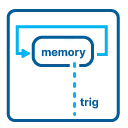
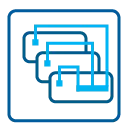

Digital Pulse Generator Option
The digital pulse generator option adds 4 internal independent pulse generators with programmable duty cycle, output frequency, delay and number of loops. These pulse generators can be triggered by software, hardware trigger or can trigger each other allowing to form complex pulse schemes to drive external equipment or experiments. The pulse generators can be outputted on the existing multi-XIO lines or can be used to trigger the instrument internally. Time resolution of the pulse generator depends on the cards type and the selected sampling rate and can be found in the technical data section.
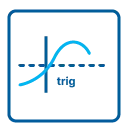
Channel Trigger
The data acquisition boards offer a wide variety of trigger modes. Besides the standard signal checking for level and edge as known from oscilloscopes it's also possible to define a window trigger. Trigger conditions can be combined with logical conjunctions like OR to adopt to different application scenarios.
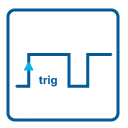
External Trigger
All boards can be triggered using a separate external trigger signal with a two level programmable window comparator and a second separate external trigger with a single programmable level comparator. It's possible to use positive or negative edge. An internally recognized trigger event can - when activated by software - be routed to a multi purpose i/o connector to start external instruments.


Multi Purpose I/O
The card offers universal multi purpose I/O lines, which can be separately programmed as either input or output. These lines can be used as additional TTL trigger inputs for more complex trigger conditions.


Spike Trigger
The trigger event is a slope inside the signal that is larger (or even smaller) than a programmed slope. Internally the difference of two adjacent samples is calculated and then compared to the programmed trigger level. This trigger mode allows the detection of signal distortions as needed for power line monitoring.
Timestamp
The timestamp option writes the time positions of the trigger events in an extra memory. The timestamps are relative to the start of recording, a defined zero time, externally synchronized to a radio clock, or a GPS receiver. With this option acquisitions of systems on different locations can be set in a precise time relation.
External Clock
Using a dedicated connector a sampling clock can be fed in from an external system. It's also possible to output the internally used sampling clock to synchronize external equipment to this clock.

High Precision PLL
The internal sampling clock of the card is generated using a high precision PLL. This powerful device allows to select the sampling rate with a fine step size making it possible to perfectly adopt to different measurement tasks. Most other cards on the market only allow the setup of fixed sampling rates like 100 MS/s, 50 MS/s, 25 MS/s, 10 MS/s, ... without any possibility to set the sampling rate to any value in between.
Reference Clock
The option to use a precise external reference clock (normally 10 MHz) is necessary to synchronize the board for high-quality measurements with external equipment (like a signal source). It's also possible to enhance the quality of the sampling clock in this way. The driver automatically generates the requested sampling clock from the fed in reference clock.
On-board Calibration
The on-board calibration can be run on user request and calibrates the amplifier against a dedicated internal high precision calibration source. After this calibration data is stored permanently in an on-board EEPROM and is automatically used for further acquisitions.

Differential Inputs
With a simple software command the inputs can individually be switched from single-ended (in relation to ground) to differential, without loosing any inputs. When the inputs are used in differential mode the A/D converter measures the difference between two lines with relation to system ground.

Programmable Input Amplifiers
The analog inputs can be adapted to real world signals using a wide variety of settings that are individual for each channel. By using software commands the input termination can be changed between 50 Ohm and 1 MOhm and one can select an input range matching the real world signal.
Programmable Input Offset
Most of the Spectrum A/D cards offer a user programmable signal offset opening the Spectrum boards to a wide variety of setups. The signal offset at least covers a range of +/-100 % of the currently selected input range making unipolar measurements with the card possible. Besides this the input range offset can be programmed individually allowing a perfect match of the A/D card section to the real world signal.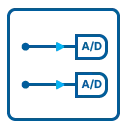







This standard driver is included in the card delivery and it is possible to get the newest driver version free of charge from our homepage at any time. There are no additional SDK fees for the classical text-based programming. All boards are delivered with drivers for Windows 7, Windows 8, Windows 10 and Windows 11, all 32 bit and 64 bit.
| Product | Channels | Max. Samplerate | Max. Bandwidth |
|---|---|---|---|
| M2p.5911-x4 | 2 | 5 MS/s | 2.50 MHz |
| M2p.5912-x4 | 4 | 5 MS/s | 2.50 MHz |
| M2p.5913-x4 | 8 | 5 MS/s | 2.50 MHz |
| M2p.5916-x4 | 4 | 5 MS/s | 2.50 MHz |
| M2p.5921-x4 | 2 | 20 MS/s | 10 MHz |
| M2p.5922-x4 | 4 | 20 MS/s | 10 MHz |
| M2p.5923-x4 | 8 | 20 MS/s | 10 MHz |
| M2p.5926-x4 | 4 | 20 MS/s | 10 MHz |
| M2p.5931-x4 | 2 | 40 MS/s | 20 MHz |
| M2p.5932-x4 | 4 | 40 MS/s | 20 MHz |
| M2p.5933-x4 | 8 | 40 MS/s | 20 MHz |
| M2p.5936-x4 | 4 | 40 MS/s | 20 MHz |
| M2p.5940-x4 | 1 | 80 MS/s | 40 MHz |
| M2p.5941-x4 | 2 | 80 MS/s | 40 MHz |
| M2p.5942-x4 | 4 | 80 MS/s | 40 MHz |
| M2p.5943-x4 | 8 | 80 MS/s | 40 MHz |
| M2p.5960-x4 | 1 | 125 MS/s | 60 MHz |
| M2p.5961-x4 | 2 | 125 MS/s | 60 MHz |
| M2p.5962-x4 | 4 | 125 MS/s | 60 MHz |
| M2p.5966-x4 | 4 | 125 MS/s | 60 MHz |
| M2p.5968-x4 | 8 | 125 MS/s | 60 MHz |


Clock / Trigger Distribution (Optional)
The Clock and Trigger Distribution card allows to externally connect several systems with a common clock and a synchronized trigger signal. One can connect up to 17 independent systems or external equipment using this card.
Docking Stations (Optional)
All Spectrum products can be used in 3rd party docking stations, connected by either PCIe interface card or by Thunderbolt interface. Docking stations can extend a standard PC by up to 16 PCIe slots.
Streaming Systems (Optional)
Combining a number of Spectrum M2p/M2i/M3i/M4i/M5i PCIe digitizers with a Tera-Store Data Streaming solution allows the capture and storage of long complex signals for extended periods of time. With systems available offering from 1 to 32 TB of storage and streaming rates up to 3 GB/s signals can be digitized and stored seamlessly for hours on end.
Documents
Signal Processing fro Digitizers |
21.02.2022 | 1 M | ||
Data sheet of the M2p.59xx series |
23.02.2024 | 820 K | ||
Manual of M2p.59xx family |
23.02.2024 | 14 M | ||
Short Manual for IVI Driver |
21.02.2022 | 532 K | ||
Manual for LabVIEW drivers for M2p |
08.12.2023 | 5 M | ||
Manual for MATLAB driver M2p/M4i/M4x/M5i/M2i/M3i/DN2/DN6 |
13.12.2023 | 1 M | ||
SCAPP Manual |
08.12.2023 | 618 K |
WINDOWS DRIVER + SOFTWARE
M2p/M4i/M4x/M5i/M2i/M3i/DN2/DN6 driver for Windows 7, 8, 10, 11 (32/64 bit) |
7.01 | 22.04.2024 | 5 M | |
C/C++ driver header and library files |
7.01 | 22.04.2024 | 43 K | |
Spectrum Control Center (32-bit) / Windows 7, 8, 10 |
2.36 | 22.04.2024 | 22 M | |
Spectrum Control Center (64-bit) / Windows 7, 8, 10, 11 |
2.36 | 22.04.2024 | 25 M | |
SBench 6 (32-bit) Installer / Windows 7, 8, 10 |
6.5.08 | 22.04.2024 | 36 M | |
SBench 6 (64-bit) Installer / Windows 7, 8, 10, 11 |
6.5.08 | 22.04.2024 | 39 M | |
Windows Installer for Remote Server Option |
22.04.2024 | 13 M | ||
IVI Driver for IVI Digitizer class (32 bit) |
22.04.2024 | 3 M | ||
IVI Driver for IVI Scope class (32 bit) |
22.04.2024 | 3 M | ||
M2i/M2p/M3i/M4i/M4x/M5i/DN2/DN6 LabView driver installer |
22.04.2024 | 19 M | ||
M2p/M4i/M4x/M5i/M2i/M3i/DN2/DN6 Matlab driver + examples installer |
22.04.2024 | 15 M | ||
Windows Examples (C/C++, .NET, Delphi, Java, Python, Julia ...) |
7.01 | 22.04.2024 | 2 M |
LINUX DRIVER + SOFTWARE
M2p/M4i/M4x/M5i/M2i/M3i drivers (Kernel + Library) for Linux 32 bit and 64 bit |
7.01 | 22.04.2024 | 12 M | |
Driver libraries (no Kernel) for Linux 32 bit and 64 bit |
7.01 | 22.04.2024 | 9 M | |
Spectrum Remote Server Linux Installer Package |
22.04.2024 | 12 K | ||
Spectrum Control Center |
2.36 | 22.04.2024 | 57 M | |
SBench 6 Linux 32 (.rpm) |
6.5.08 | 22.04.2024 | 26 M | |
SBench 6 Linux 64 (.rpm) |
6.5.08 | 22.04.2024 | 26 M | |
SBench 6 Linux 32 (.deb) |
6.5.08 | 22.04.2024 | 23 M | |
SBench 6 Linux 64 (.deb) |
6.5.08 | 22.04.2024 | 22 M | |
SBench6 Jetson (.deb) |
6.5.08 | 22.04.2024 | 11 M | |
Drivers + examples for MATLAB for Linux (DEB + RPM) |
22.04.2024 | 183 K | ||
Linux Examples (C/C++, Python, Julia ...) |
7.01 | 22.04.2024 | 560 K |
Firmware
M2i/M2p/M3i/M4i/M4x/M5i firmware update (Windows) |
22.04.2024 | 22 M | ||
M2i/M2p/M3i/M4i/M4x/M5i firmware update (Linux) |
22.04.2024 | 30 M |
Case Studies
| OCT Skin Cancer Scanner | OCT application for skin cancer diagnosis |
21.02.2022 | 351 K | |
| CS Automotive Data Recorder | Case Automotive Data Study Recorder and Playback Solution |
21.02.2022 | 278 K | |
| CS Mass Spectroscopy | Case Study: Digitizer in Mass Spectroscopy |
21.02.2022 | 533 K | |
| CS Digitizer at Cern | Case Study: Digitizers and AWGs at Cerns LHC Beam Dumping System |
21.02.2022 | 532 K | |
| CS Spectrum Digitizers at DESY | Case Study: Spectrum Digitizers playing vital role at DESY |
21.02.2022 | 982 K | |
| CS DIAL - Differential Absorption LIDAR | Case Study DIAL - Differential Absorption LIDAR |
22.02.2022 | 2 M | |
| CS Time Reversal Focusing | Case Study: High Amplitude Time Reversal Focusing of Acoustic Waves |
21.02.2022 | 6 M | |
| CS Atmospheric Lidar | Case Study: Digitizers and AWG used for Atmospheric Research |
21.02.2022 | 939 K | |
| CS Digitizer for Cell Sorting | Case Study Fast Digitizer from Spectrum enables breakthrough in cell sorting |
21.02.2022 | 851 K | |
| CS Fusion Research | Case Study: Digitizers from Spectrum in Fusion Research |
21.02.2022 | 2 M | |
| CS Road Radar | Case Study: Digitizers used for intelligent road-radar to detect wild animals |
21.02.2022 | 3 M | |
| MRI Scanner for Babies | Shrunken MRI scanner helps in saving lives of sick babies |
21.02.2022 | 195 K | |
| CS Atomic Force Microscope | Case Study: Atomic Force Microscope scanning surfaces |
27.07.2022 | 293 K | |
| CS BYU Underwater Acoustics Lab | Case Study Sound waves studied in a simulated ocean with high-precision PCIe measurement cards |
18.11.2022 | 469 K | |
| CS Lighning Research with Digitizer | Case Study: ADC cards by Spectrum Instrumentation help to reveal the secrets of how lightning forms |
28.03.2024 | 418 K |
Product Notes
| General Digitizer Introduction | General Introduction to Waveform Digitizers |
21.02.2022 | 587 K | |
| Digitizer Acquisition Modes | Using modular Digitizer Acquisition Modes |
21.02.2022 | 3 M | |
| Digitizer Front-End | Proper Use of Digitizer Front-End Signal Conditioning |
21.02.2022 | 3 M | |
| Trigger and Sync | Trigger, Clock and Synchronization Details at high-speed Digitizers |
21.02.2022 | 1 M | |
| Digitizer Software Integration | Software Support for Modular Digitizers |
21.02.2022 | 724 K | |
| SBench 6 Introduction | SBench 6 - Data Acquisition and Analysis of Digitizer Data |
21.02.2022 | 1 M | |
| PN 16 Bit Digitizer Comparison - high precision design | Product Note: Designing PCIe Digitizers for very high precision measurements |
21.02.2022 | 696 K |
Application Notes
| Ultrasonic Applications | Using Digitizers in Ultrasonic Applications |
21.02.2022 | 617 K | |
| Signal Processing Tools | Using Signal Processing Tools to enhance Digitizer Data |
21.02.2022 | 1 M | |
| Using Probes & Sensors | Using Probes and Sensors with Modular Digitizers |
21.02.2022 | 858 K | |
| Solving Data Transfer Bottlenecks on Digitizers | Solving Data Transfer Bottlenecks on Digitizers |
21.02.2022 | 2 M | |
| Teaming AWG with Digitizer | Teaming an Arbitrary Waveform Generator with a Modular Digitizer |
21.02.2022 | 919 K | |
| Common Digitizer Setup Problems | Application Note: Common Digitizer Setup Problems to avoid |
21.02.2022 | 1 M | |
| Mechanical Measurements D | Mechanische Messungen mit modularen Digitizern |
21.02.2022 | 1 M | |
| Mass Spectroscopy | Application Note Mass Spectroscopy |
21.02.2022 | 879 K | |
| AN Vehicular Testing with Modular Instruments | Application Note: Vehicular Testing with Modular Instruments |
21.02.2022 | 1 M | |
| AN LIDAR Light Detection and Ranging | Application Note LIDAR - Light Detection and Ranging |
21.02.2022 | 528 K | |
| AN Testing Power Supplies | Application Note: Testing Power Supplies using Modular Digitizers |
21.02.2022 | 898 K | |
| AN Amplitude Resolution | Application Note: The Amplitude Resolution of Digitizers and how it affects Measurements |
21.02.2022 | 555 K | |
| AN Radar Signal Acquisition | Application Note: Radar Signal Acquisition with Modular Digitizer |
21.02.2022 | 771 K | |
| AN Dynamic Parameters and Digitizers | Application Note: Dynamic Parameters and Waveform Digitizers |
21.02.2022 | 711 K | |
| AN Closed Loop Digitizer+AWG | Application Note: Closed Loop Tests with Digitizer and AWG and CUDA-GPU |
21.02.2022 | 2 M | |
| Aircraft Systems Testing | Testing electronic aircraft systems using modular instruments |
21.02.2022 | 3 M | |
| AN Multi-Channel T&M Systems | Easy creation of customized multi-channel, multi-functional T&M systems |
21.02.2022 | 2 M |
White Papers
| Software block averaging | Using software based fast block averaging |
21.02.2022 | 649 K |

